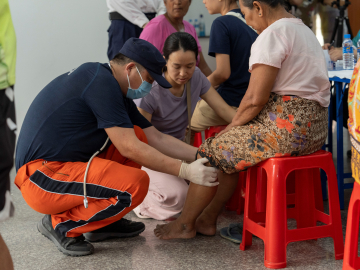Language Reform Drives Change in Road Safety Journalism
Several years after David’s death by motorcycle collision, his wife, Tatiana, and his daughter are still haunted by a question: What if things had been different?
Tatiana’s testimonial, in a moving public service announcement that aired in Colombia in August 2023, is one of many media campaigns aired around the world that remind us that road “accidents” are not accidents: Road crashes are almost always preventable.
With a staggering global death toll of 1.19 million lives per year, road crashes stand as the leading cause of death for people aged 5 to 29 years. Yet many people consider road traffic crashes happenstances—and media messaging plays a big role in maintaining that narrative.
Media coverage shapes public attitudes, and, in turn, policy priorities. Research shows that the media only covers the most dramatic crashes. And the crashes are commonly depicted as episodic—one-off “accidents” attributed to human error or “bad luck,” and often, as the victim’s fault. This characterization matters more than many may realize to the safety of pedestrians and other road users.
Road injuries are a symptom of systemic issues—ranging from roads designed to prioritize moving cars over pedestrians to a lack of best-practice laws that help make roads safe. Framing them as isolated and inevitable “accidents” that are beyond our control implies that the solution is elusive.
On the contrary, solutions exist and are attainable. By implementing best practices to communicate that road safety is a public health issue and that crashes are largely preventable, the media has the power to shift general attitudes and understanding of the crisis.
Studies demonstrate that training works. Between 2017 and 2021, the global health organization Vital Strategies, as part of the Bloomberg Philanthropies Initiative for Global Road Safety, supported government-led journalist training in Colombia to reconstruct the narrative of road safety as a public health issue.
In Colombia, road traffic crashes are the eighth leading cause of death for people of all ages and caused nearly 9,000 fatalities on the country’s roads in 2016, the year preceding the Frontiers study mentioned above. Since Colombia, like the vast majority of countries, was not able to meet the UN goal of cutting road traffic fatalities in half from 2011 to 2020, an urgent need emerged to focus on road safety initiatives and preventative measures.
The trainings encouraged journalists to use the WHO’s guide for journalists covering road safety, which suggests story angles and key elements that help place traffic crashes in the context of broader, systemic road safety and public health issues. Moreover, the guide recommends that news reports should focus on the human story by highlighting survivor perspectives and using neutral road-incident vocabulary, like “crash” over “accident.”
The journalist trainings led to measurable improvements in reporting language. Colombia saw a 27% increase in articles that framed road traffic crashes as a systemic issue and used the terms “crash” and “collision.” Of the 870 articles analyzed, almost all employed at least one WHO-recommended story angle (96%) and key element (95%).
Despite improvements in Colombia’s road safety coverage regionally and nationally, the work is far from over. There must be a united and more concerted effort for journalists to address the way their outlets and fellow reporters frame crashes.
Improving road safety media coverage will require sustained discourse between journalists, road safety stakeholders, and public health experts to determine which nuances in language feed the problematic view of road traffic crashes as inevitable. But whether through in-house media training or road safety reporting guides for dissemination, change starts with education and can start today. By working to change the media narrative, we can create a ripple that will ultimately shift public knowledge, behaviors, and advocacy for road safety.
Words matter and inform our reality. When we as writers and communicators make it a priority to commit to language reform, we can not only change public opinions of road safety, but also spare people who lost their lives in road crashes—and their families— the injustice of being dismissed as an “accident.”
Kristi Saporito serves as deputy director for Vital Strategies’ Road Safety Program. Saporito, who has over a decade of strategic communication experience, works with colleagues and partners across the world to support behavior change communication and engagement with media to promote road safety best practices that save lives.
Join the 50,000+ subscribers in 170+ countries who rely on Global Health NOW summaries and exclusive articles for the latest public health news. Sign up for our free weekday newsletter, and please share the link with friends and colleagues.
Police in Bogota conduct speeding checkpoints a key part of a comprehensive road safety strategy in 2022. Bogota Secretariat of Mobility





